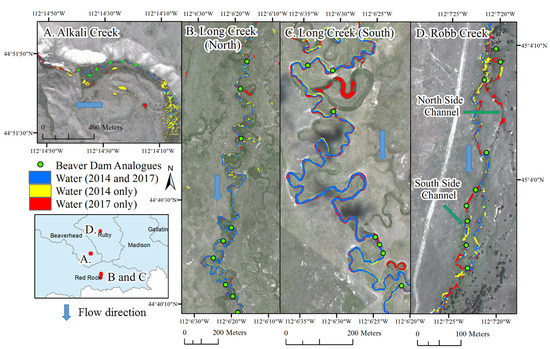Applying High-Resolution Imagery to Evaluate Restoration-Induced Changes in Stream Condition, Missouri River Headwaters Basin, Montana
Abstract
1. Introduction
- What methodological approaches are most effective to map stream surface area using multispectral high-resolution imagery? And,
- How can image pairs (e.g., pre- and post-restoration) be used to monitor changes in stream surface area and riparian greenness?
2. Methods
2.1. Study Area and Restoration Activities
2.2. Image Acquisition and Preprocessing
2.3. Object-Based Water Classification
2.4. Pixel-Based Water Classification
2.5. Stream Surface Area Validation
2.6. Changes in Stream Surface Area
2.7. Changes in Riparian Condition
3. Results
3.1. Accuracy of Stream Delineation Approaches
3.2. Changes to Stream Condition
3.3. Changes to Riparian Condition
4. Discussion
5. Conclusions
Author Contributions
Acknowledgments
Conflicts of Interest
References
- Smith, L.C. Satellite remote sensing of river inundation area, stage, and discharge: A review. Hydrol. Process. 1997, 11, 1427–1439. [Google Scholar] [CrossRef]
- Alsdorf, D.E.; Rodriguez, E.; Lettenmaier, D.P. Measuring surface water from space. Rev. Geophys. 2007, 45. [Google Scholar] [CrossRef]
- Wang, J.J.; Lu, X.X.; Liew, S.C.; Zhou, Y. Retrieval of suspended sediment concentrations in large turbid rivers using Landsat ETM+: An example from the Yangtze River, China. Earth Surf. Process. Landf. 2009, 34, 1082–1092. [Google Scholar] [CrossRef]
- Wang, Y.; Colby, J.D.; Mulcahy, K.A. An efficient method for mapping flood extent in a coastal floodplain using Landsat TM and DEM data. Int. J. Remote Sens. 2002, 23, 3681–3696. [Google Scholar] [CrossRef]
- Qi, S.; Brown, D.G.; Tian, Q.; Jiang, L.; Zhao, T.; Bergen, K.M. Inundation extent and flood frequency mapping using Landsat imagery and Digital Elevation Models. GISci. Remote Sens. 2009, 46, 101–127. [Google Scholar] [CrossRef]
- Chen, Y.; Huang, C.; Ticchurst, C.; Merrin, L.; Thew, P. An evaluation of MODIS daily and 8-day composite products for floodplain and wetland inundation mapping. Wetlands 2013, 33, 823–835. [Google Scholar] [CrossRef]
- Ogilvie, A.; Belaud, G.; Belenne, C.; Bailly, J.S.; Bader, J.C.; Oleksiak, A.; Ferry, L.; Martin, D. Decadal monitoring of the Niger Inner Delta flood dynamics using MODIS optical data. J. Hydrol. 2015, 523, 368–383. [Google Scholar] [CrossRef]
- Schumann, G.; Di Baldassarre, G.; Alsdorf, D.E.; Bates, P.D. Near real-time flood wave approximation on large rivers from space: Application to the River Po, Northern Italy. Water Resour. Res. 2010, 46, W05601. [Google Scholar] [CrossRef]
- Allen, G.H.; Pavelsky, T.M. Patterns of river width and surface area revealed by the satellite-derived North American River Width data set. Geophys. Res. Lett. 2015, 42, 395–402. [Google Scholar] [CrossRef]
- Hotchkiss, E.R.; Hall, R.O., Jr.; Sponseller, R.A.; Butman, D.; Klaminder, J.; Laudon, H.; Rosvall, M.; Karisson, J. Sources of and processes controlling CO2 emissions change with the size of streams and rivers. Nat. Geosci. 2015, 8, 696–699. [Google Scholar] [CrossRef]
- Demarchi, L.; Bizzi, S.; Piegay, H. Hierarchical object-based mapping of riverscape units and in-stream mesohabitats using LiDAR and VHR imagery. Remote Sens. 2016, 8, 97. [Google Scholar] [CrossRef]
- Lang, M.W.; McCarty, G.W. Lidar intensity for improved detection of inundation below the forest canopy. Wetlands 2009, 29, 1166–1178. [Google Scholar] [CrossRef]
- Wu, Q.; Lane, C.R. Delineating wetland catchments and modeling hydrologic connectivity using lidar data and aerial imagery. Hydrol. Earth Syst. Sci. 2017, 21, 3579–3595. [Google Scholar] [CrossRef]
- Clewley, D.; Whitcomb, J.; Moghaddam, M.; McDonald, K.; Chapman, B.; Bunting, P. Evaluation of ALOS PALSAR data for high-resolution mapping of vegetated wetlands in Alaska. Remote Sens. 2015, 7, 7272–7297. [Google Scholar] [CrossRef]
- Hess, L.L.; Melack, J.M.; Affonso, A.G.; Barbosa, C.; Gastil-Buhl, M.; Novo, E.M.L.M. Wetlands of the lowland Amazon basin: Extent, vegetative cover, and dual-season inundated area as mapped with JERS-1 synthetic aperture radar. Wetlands 2015, 35, 745–756. [Google Scholar] [CrossRef]
- Schlaffer, S.; Chini, M.; Dettmering, D.; Wagner, W. Mapping wetlands in Zambia using seasonal backscatter signatures derived from ENVISaT ASaR time series. Remote Sens. 2016, 8, 402. [Google Scholar] [CrossRef]
- White, D.C.; Lewis, M.M. A new approach to monitoring spatial distribution and dynamics of wetlands and associated flows of Australian Great Artesian Basin springs using QuickBird satellite imagery. J. Hydrol. 2011, 408, 140–152. [Google Scholar] [CrossRef]
- Whiteside, T.G.; Bartolo, R.E. Mapping aquatic vegetation in a tropical wetland using high spatial resolution multispectral satellite imagery. Remote Sens. 2015, 7, 11664–11694. [Google Scholar] [CrossRef]
- Liébault, F.; Piegay, H. Assessment of channel changes due to long term bedload supply decrease, Roubion River, France. Geomorphology 2001, 36, 167–186. [Google Scholar] [CrossRef]
- Bollati, I.M.; Pellegrini, L.; Rinaldi, M.; Duci, G.; Pelfini, M. Reach-scale morphological adjustments and stages of channel evolution: The case of the Trebbia River (northern Italy). Geomorphology 2014, 221, 176–186. [Google Scholar] [CrossRef]
- Toone, J.; Rice, S.P.; Piégay, H. Spatial discontinuity and temporal evolution of channel morphology along a mixed bedrock-alluvial river, upper Drôme River, southeast France: Contingent responses to external and internal controls. Geomorphology 2014, 205, 5–16. [Google Scholar] [CrossRef]
- Belletti, B.; Dufour, S.; Piégay, H. What is the relative effect of space and time to explain the braided river width and island patterns at a regional scale? River Res. Appl. 2013, 31, 1–15. [Google Scholar] [CrossRef]
- Bertrand, M.; Piégay, H.; Pont, D.; Liébault, F.; Sauquet, E. Sensitivity analysis of environmental changes associated with riverscape evolutions following sediment reintroduction: Geomatic approach on the Drôme River network, France. Int. J. River Basin Manag. 2013, 11, 19–32. [Google Scholar] [CrossRef]
- Marcus, W.A.; Fonstad, M.A. Optical remote mapping of rivers at sub-meter resolutions and watershed extents. Earth Surf. Process. Landf. 2008, 33, 4–24. [Google Scholar] [CrossRef]
- Jiang, H.; Feng, M.; Zhu, Y.; Lu, N.; Huang, J.; Xiao, T. An automated method for extracting rivers and lakes form Landsat imagery. Remote Sens. 2014, 6, 5067–5089. [Google Scholar] [CrossRef]
- Goklany, I.M. Comparing 20th century trends in U.S. and global agricultural water and land use. Water Int. 2002, 27, 321–329. [Google Scholar] [CrossRef]
- Schaible, G.D.; Aillery, M.P. Water Conservation in Irrigated Agriculture: Trends and Challenges in the Face of Emerging Demands; EIB-99; U.S. Department of Agriculture, Economic Research Service: Washington, DC, USA, 2012.
- Hansen, A.J.; Rasker, R.; Maxwell, B.; Rotella, J.J.; Johnson, J.D.; Parmenter, A.W.; Langner, U.; Cohen, W.B.; Lawrence, R.L.; Kraska, P.V. Ecological causes and consequences of demographic change in the new west. Bioscience 2002, 52, 151–162. [Google Scholar] [CrossRef]
- Gude, P.H.; Hansen, A.J.; Rasker, R.; Maxwell, B. Rates and drivers of rural residential development in the Greater Yellowstone. Landsc. Urban Plan. 2006, 77, 131–151. [Google Scholar] [CrossRef]
- Pederson, G.T.; Gray, S.T.; Woodhouse, C.A.; Betancourt, J.L.; Fagre, D.B.; Littell, J.S.; Watson, E.; Luckman, B.H.; Graumlich, L.J. The Unusual Nature of Recent Snowpack Declines in the North American Cordillera. Science 2011, 333, 332–335. [Google Scholar] [CrossRef] [PubMed]
- Pederson, G.T.; Betancourt, J.L.; McCabe, G.J. Regional patterns and proximal causes of the 60 recent snowpack decline in the Rocky Mountains, U.S. Geophys. Res. Lett. 2013, 40, 1811–1816. [Google Scholar] [CrossRef]
- U.S. Bureau of Reclamation. Climate Change Analysis for the Missouri River Basin; Technical Memorandum No. 86-68210-2012-03; U.S. Bureau of Reclamation: Washington, DC, USA, 2012.
- Lemly, A.D.; Kingsford, R.T.; Thomson, J.R. Irrigated agriculture and wildlife conservation: Conflict on a global scale. Environ. Manag. 2000, 25, 485–512. [Google Scholar] [CrossRef] [PubMed]
- Isaak, D.J.; Wollrab, S.; Horan, D.; Chandler, G. Climate change effects on stream and river temperatures across the northwest U.S. from 1980–2009 and implications for salmonid fishes. Clim. Chang. 2012, 113, 499–524. [Google Scholar] [CrossRef]
- Ziemer, L.S.; Kendy, E.; Wilson, J. Ground water management in Montana: On the road from beleaguered to science-based policy. Public Land Resour. Law Rev. 2006, 76, 75–97. [Google Scholar]
- Jones, H.P.; Hole, D.G.; Zavaleta, E.S. Harnessing nature to help people adapt to climate change. Nat. Clim. Chang. 2012, 2, 504–509. [Google Scholar] [CrossRef]
- Gartner, T.; Mulligan, J.; Schmidt, R.; Gunn, J. Natural Infrastructure; World Resources Institute: Washington, DC, USA, 2013; Volume 56, p. 18. [Google Scholar]
- Acreman, M.; Holden, J. How Wetlands Affect Floods. Wetlands 2013, 33, 773–786. [Google Scholar] [CrossRef]
- Montana Department of Natural Resources and Conservation. The 2015 Montana State Water Plan; Montana Department of Natural Resources and Conservation: Helena, MT, USA, 2015; 20p.
- Kemp, P.S.; Worthington, T.A.; Langford, T.E.L.; Tree, A.R.J.; Gaywood, M.J. Qualitative and quantitative effects of reintroduced beavers on stream fish. Fish Fish. 2012, 13, 158–181. [Google Scholar] [CrossRef]
- Pollock, M.M.; Beechie, T.J.; Wheaton, J.M.; Jordan, C.E.; Bouwes, N.; Weber, N.; Volk, C. Using Beaver Dams to Restore Incised Stream Ecosystems. Bioscience 2014, 64, 279–290. [Google Scholar] [CrossRef]
- Bouwes, N.; Weber, N.; Jordan, C.E.; Saunders, C.; Tattam, I.A.; Volk, C.; Wheaton, J.M.; Pollock, M.M. Ecosystem experiment reveals benefits of natural and simulated beaver dams to a threatened population of steelhead (Oncorhynchus mykiss). Sci. Rep. 2016, 6, 1–12. [Google Scholar] [CrossRef] [PubMed]
- Hill, A.R.; Duval, T.P. Beaver dams along an agricultural stream in southern Ontario, Canada: Their impact on riparian zone hydrology and nitrogen chemistry. Hydrol. Process. 2009, 23, 1324–1336. [Google Scholar] [CrossRef]
- Knopf, F.L.; Johnson, R.R.; Rich, T.; Samson, F.B.; Szaro, R.C. Conservation of riparian systems in the United States. Wilson Bull. 1988, 100, 272–284. [Google Scholar]
- Gurnell, A.M. The hydrogeomorphological effects of beaver dam-building activity. Prog. Phys. Geogr. 1998, 22, 167–189. [Google Scholar] [CrossRef]
- PRISM Climate Group, Oregon State University. Available online: http://prism.oregonstate.edu (accessed on 10 July 2012).
- Homer, C.; Dewitx, J.; Yang, L.; Jin, S.; Danielson, P.; Xian, G.; Coulston, J.; Herold, N.; Wickham, J.; Megown, K. Completion of the 2011 National Land Cover Database for the conterminous United States—Representing a decade of land cover change information. Photogramm. Eng. Remote Sens. 2015, 81, 345–354. [Google Scholar]
- Podolak, K.; Kelsey, R.; Harris, S.; Korb, N. Why the Nature Conservancy is Restoring Streams by Acting Like a Beaver. Cool Green Science, Nature Conservancy. Available online: https://blog.nature.org/science (accessed on 22 January 2018).
- Pollock, M.M.; Lewallen, G.; Woodruff, K.; Jordan, C.E.; Castro, J.M. (Eds.) The Beaver Restoration Guidebook: Working with Beaver to Restore Streams, Wetlands, and Floodplains; version 1.0; United States Fish and Wildlife Service: Portland, OR, USA, 2015; 189p. Available online: http://www.fws.gov/oregonfwo/ToolsForLandowners/RiverScience/Beaver.asp (accessed on 22 January 2018).
- Gesch, D.; Oimoen, M.; Greenlee, S.; Nelson, C.; Steuck, M.; Tyler, D. The National Elevation Dataset. Photogramm. Eng. Remote Sens. 2002, 68, 5–11. [Google Scholar]
- Zhang, Y. Problems in the fusion of commercial high-resolution satellite as well as LANDSAT 7 images and initial solutions. In GeoSpatial Theory, Processing and Applications; ISPRS: Ottawa, ON, Canada, 2002; Volume 34, Part 4. [Google Scholar]
- Li, H.; Jing, L.; Tang, Y. Assessment of pansharpening methods applied to WorldView-2 imagery fusion. Sensors 2017, 17, 89. [Google Scholar] [CrossRef] [PubMed]
- Marchisio, G.; Pacifici, F.; Padwick, C. On the relative predictive value of the new spectral bands in the WorldView-2 sensor. In Proceedings of the 2010 IEEE International Geoscience and Remote Sensing Symposium (IGARSS), Honolulu, HI, USA, 25–30 July 2010; pp. 2723–2726. [Google Scholar]
- McFeeters, S.K. The use of the Normalized Difference Water Index (NDWI) in the delineation of open water features. Int. J. Remote Sens. 1996, 17, 1425–1432. [Google Scholar] [CrossRef]
- Wolf, A.F. Using Worldview-2 Vis-NIR multispectral imagery to support land mapping and features extraction using normalized difference index ratios. In Proceedings SPIE 8390, Algorithms and Technologies for Multispectral, Hyperspectral, and Ultraspectral Imagery XVIII; SPIE: Baltimore, MD, USA, 2012; p. 83900N. [Google Scholar]
- Liu, H.Q.; Huete, A.R. A feedback based mpoiodification of the NDVI to minimize canopy background and atmospheric noise. IEEE Trans. Geosci. Remote Sens. 1995, 33, 457–465. [Google Scholar]
- Huete, A.R.; Liu, H.Q.; Batchily, K.; YanLeeuwen, W. A comparison of vegetation indices global set of TM images for EOS-MODIS. Remote Sens. Environ. 1997, 59, 440–451. [Google Scholar] [CrossRef]
- Tucker, C.J. Red and photographic infrared linear combinations for monitoring vegetation. Remote Sens. Environ. 1979, 8, 127–150. [Google Scholar] [CrossRef]
- Falkowski, M.J.; Gessler, P.E.; Morgan, P.; Hudak, A.T.; Smith, A.M.S. Characterizing and mapping forest fire fuels using ASTER imagery and gradient modeling. For. Ecol. Manag. 2005, 217, 129–146. [Google Scholar] [CrossRef]
- Jawak, S.D.; Luis, A.J. A spectral index ratio-based Antarctic land-cover mapping using hyperspatial 8-band WorldView-2 Imagery. Polar Sci. 2013, 7, 18–38. [Google Scholar] [CrossRef]
- Myint, S.W.; Gober, P.; Brazel, A.; Grossman-Clarke, S.; Weng, Q. Per-pixel vs. Object-based classification of urban land cover extraction using high spatial resolution imagery. Remote Sens. Environ. 2011, 115, 1145–1161. [Google Scholar] [CrossRef]
- Stumpf, R.P.; Holderied, K.; Sinclair, M. Determination of water depth with high-resolution satellite imagery over variable bottom types. Limnol. Oceanogr. 2003, 48, 547–556. [Google Scholar] [CrossRef]
- Youden, W.J. Index for rating diagnostic tests. Cancer 1950, 3, 32–35. [Google Scholar] [CrossRef]
- Lopez-Raton, M.; Rodriguez-Alvarez, M.X. Package “OptimalCutpoints”. Available online: http://cran.r-project.org/web/packages/OptimalCutpoints/OptimalCutpoints.pdf (accessed on 11 May 2018).
- Fleiss, J.L. Statistical Methods for Rates and Proportions, 2nd ed.; John Wiley & Sons: New York, NY, USA, 1981. [Google Scholar]
- Forbes, A.D. Classification-algorithm evaluation: Five performance measures based on confusion matrices. J. Clin. Monit. 1995, 11, 189–206. [Google Scholar] [CrossRef] [PubMed]
- Liro, M. Conceptual model for assessing the channel changes upstream from dam reservoir. Quaest. Geogr. 2014, 33, 61–74. [Google Scholar] [CrossRef]
- Huete, A.R. A soil-adjusted vegetation index (SAVI). Remote Sens. Environ. 1988, 25, 295–309. [Google Scholar] [CrossRef]
- Baret, F.; Guyot, G. Potentials and limits of vegetation indices for LAI and APAR assessment. Remote Sens. Environ. 1991, 35, 161–173. [Google Scholar] [CrossRef]
- Qi, J.; Huete, A.R.; Moran, M.S.; Chehbouni, A.; Jackson, R.D. Interpretation of vegetation indices derived from multi-temporal SPOT images. Remote Sens. Environ. 1993, 44, 89–101. [Google Scholar] [CrossRef]
- Stromberg, J.C. Restoration of riparian vegetation in the south-western United States: Importance of flow regimes and fluvial dynamism. J. Arid Environ. 2001, 49, 17–34. [Google Scholar] [CrossRef]
- Richardson, D.M.; Holmes, P.M.; Esler, K.J.; Galatowitsch, S.M.; Stromberg, J.C.; Kirkman, S.P.; Pysek, P.; Hobbs, R.J. Riparian vegetation: Degradation, alien plant invasions, and restoration prospects. Divers. Distrib. 2007, 13, 126–139. [Google Scholar] [CrossRef]
- Mouillot, F.; Schultz, M.G.; Yue, C.; Cadule, P.; Tansey, K.; Ciais, P.; Chuvieco, E. Ten years of global burned area products from spaceborne remote sensing—A review: Analysis of user needs and recommendations for future developments. Int. J. Appl. Earth Obs. Geoinf. 2014, 26, 64–79. [Google Scholar] [CrossRef]
- Galvão, L.S.; Filho, W.P.; Abdon, M.M.; Novo, E.M.M.L.; Silva, J.S.V.; Ponzoni, F.J. Spectral reflectance characterization of shallow lakes from the Brazilian Pantanal wetlands with field and airborne hyperspectral data. Int. J. Remote Sens. 2003, 24, 4093–4112. [Google Scholar] [CrossRef]
- Tyler, A.N.; Svab, E.; Preston, T.; Presing, M.; Kovacs, W.A. Remote sensing of the water quality of shallow lakes: A mixture modelling approach to quantifying phytoplankton in water characterized by high-suspended sediment. Int. J. Remote Sens. 2006, 27, 1521–1537. [Google Scholar] [CrossRef]
- McCabe, M.F.; Aragon, B.; Houborg, R.; Mascaro, J. CubeSats in hydrology: Ultrahigh-resolution insights into vegetation dynamics and terrestrial evaporation. Water Resour. Res. 2017. [Google Scholar] [CrossRef]
- Rood, S.B.; Gourley, C.R.; Ammon, E.M.; Heki, L.G.; Klotz, J.R.; Morrison, M.L.; Mosley, D.; Scoppettone, G.G.; Swanson, S.; Wagner, P.L. Flows for floodplain forests: A successful riparian restoration. BioScience 2003, 53, 647–656. [Google Scholar] [CrossRef]
- Stromberg, J.C.; Lite, S.J.; Rychener, T.J.; Levick, L.R.; Dixon, M.D.; Watts, J.M. Status of the riparian ecosystem in the Upper San Pedro River, Arizona: Application of an assessment model. Environ. Monit. Assess. 2006, 115, 145–173. [Google Scholar] [CrossRef] [PubMed]
- Jones, K.B.; Edmonds, C.E.; Slonecker, E.T.; Wickham, J.D.; Neale, A.C.; Wade, T.G.; Riiters, K.H.; Kepner, W.G. Detecting changes in riparian habitat conditions based on patterns of greenness change: A case study from the Upper San Pedro River Basin, USA. Ecol. Indic. 2008, 8, 89–99. [Google Scholar] [CrossRef]
- Bizzi, S.; Demarchi, L.; Grabowski, C.; Weissteiner, C.J.; Van de Bund, W. The use of remote sensing to characterize hydromorphological properties of European rivers. Aquat. Sci. 2016, 78, 57–70. [Google Scholar] [CrossRef]

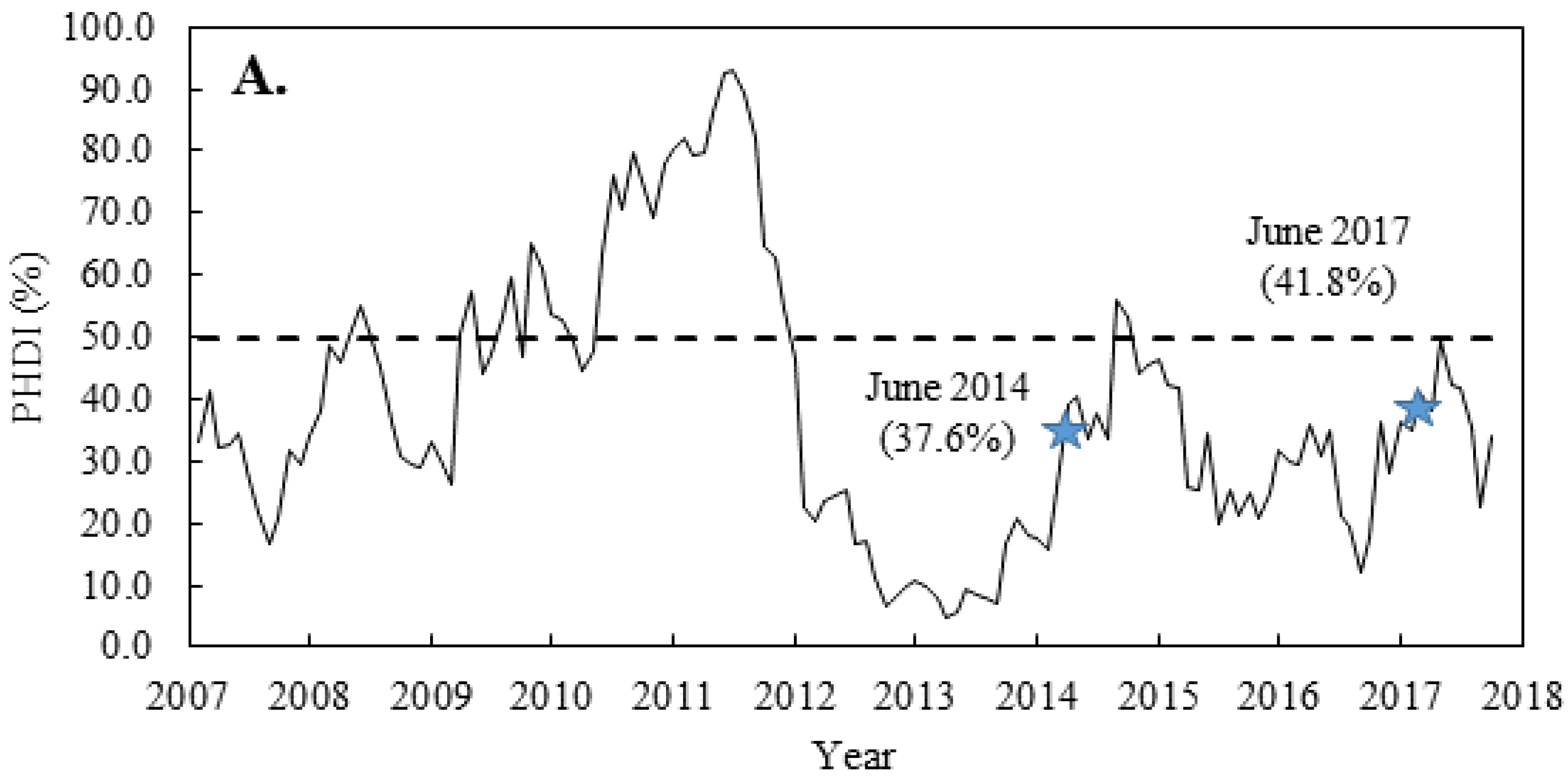
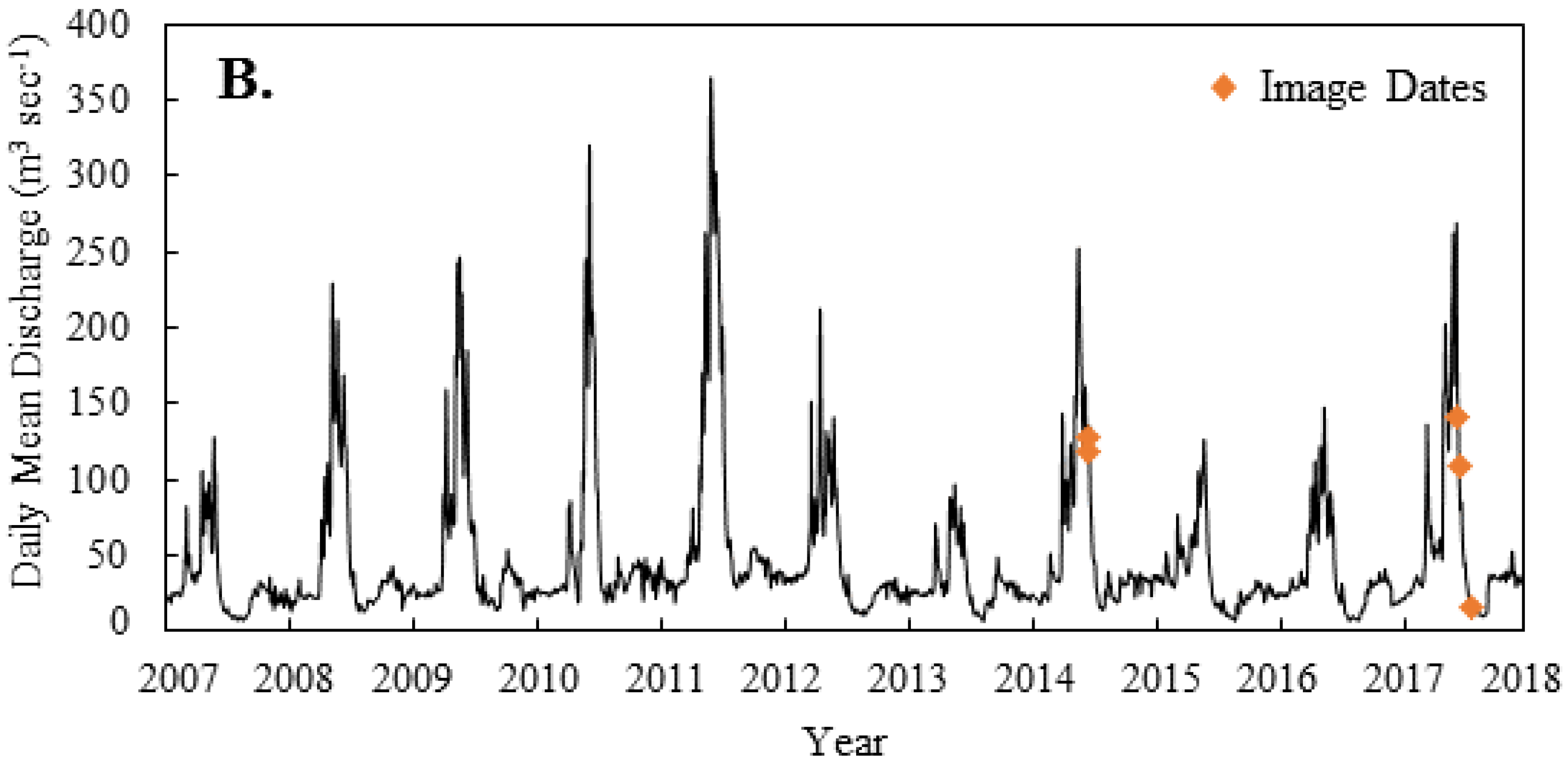
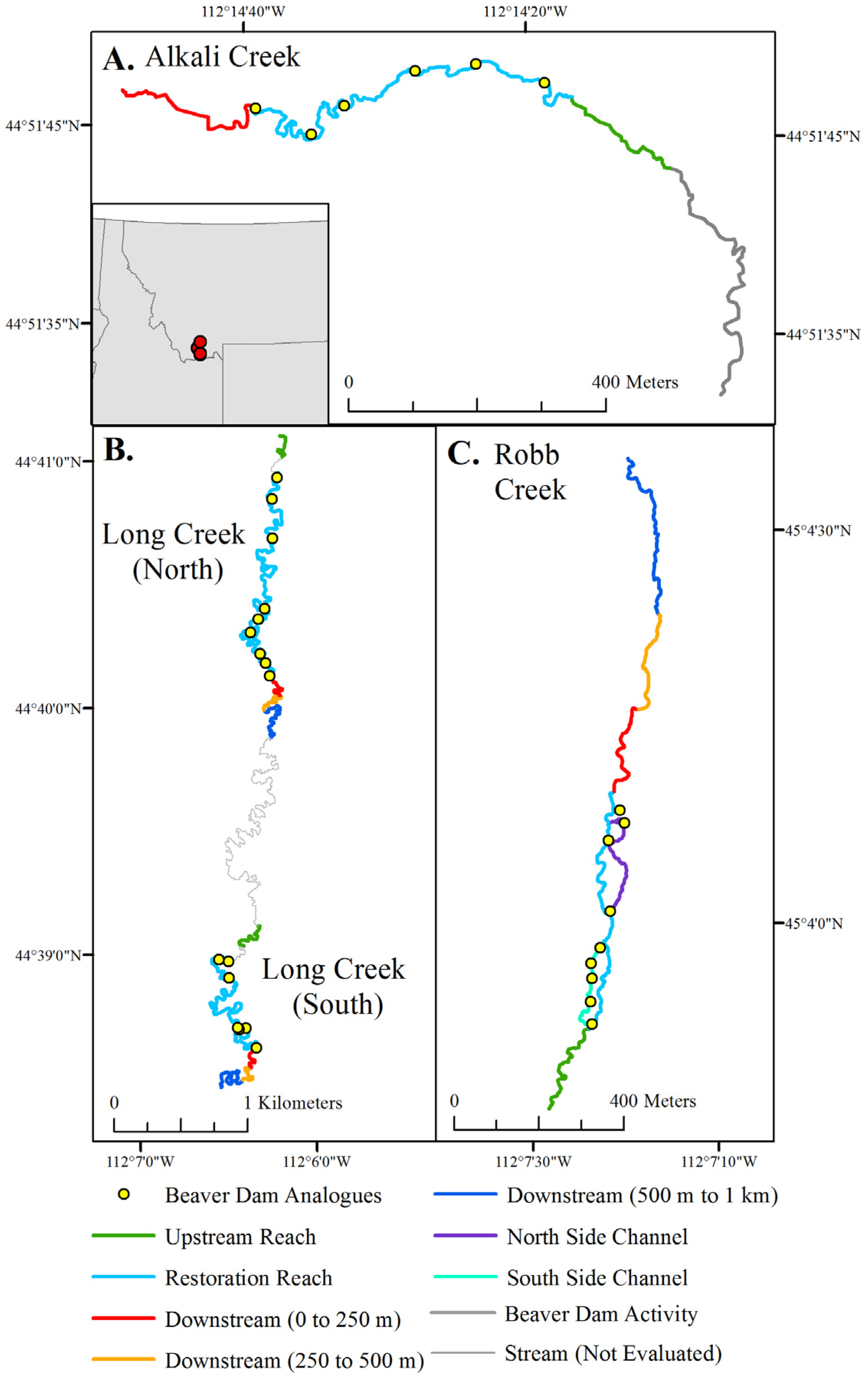
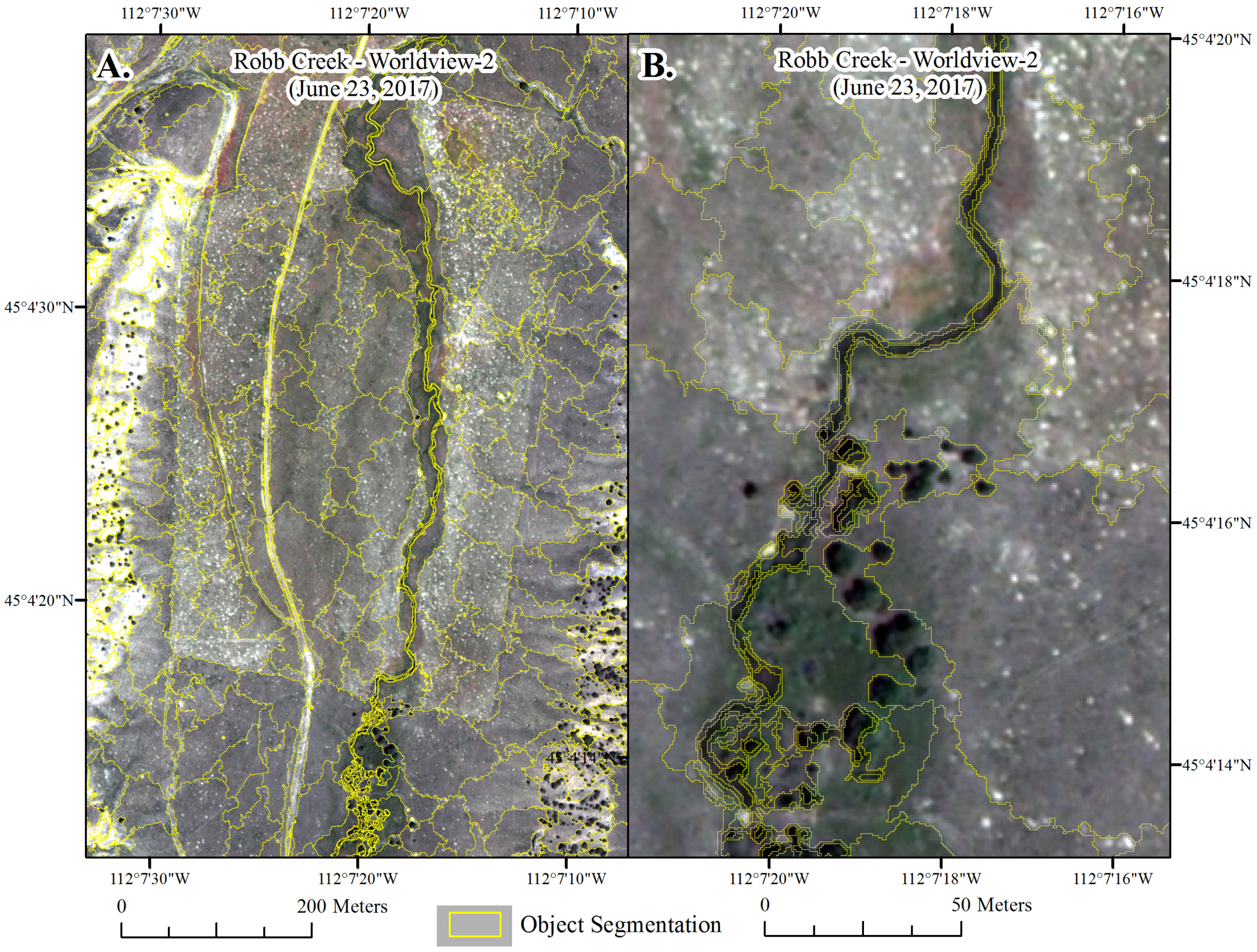
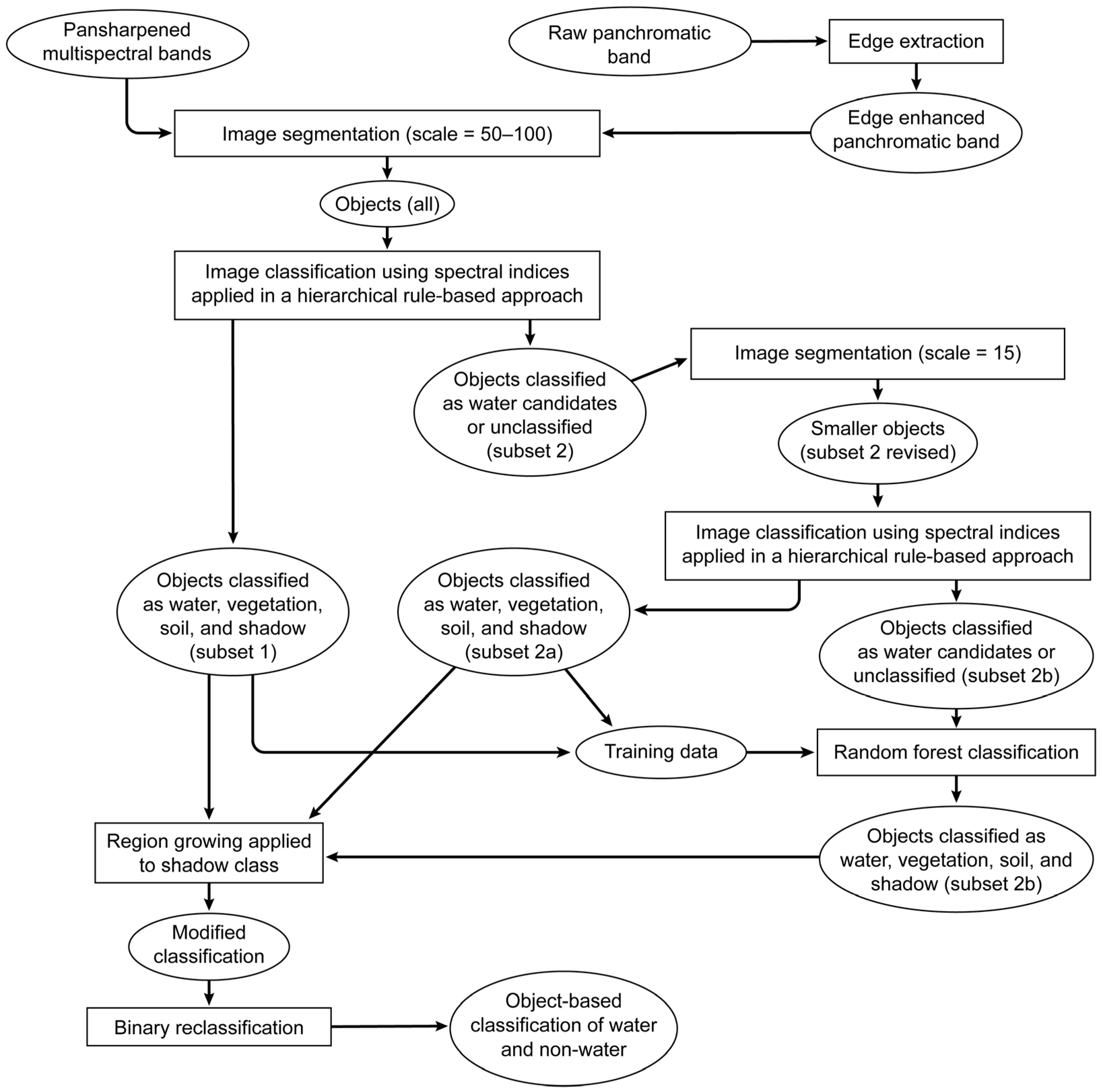
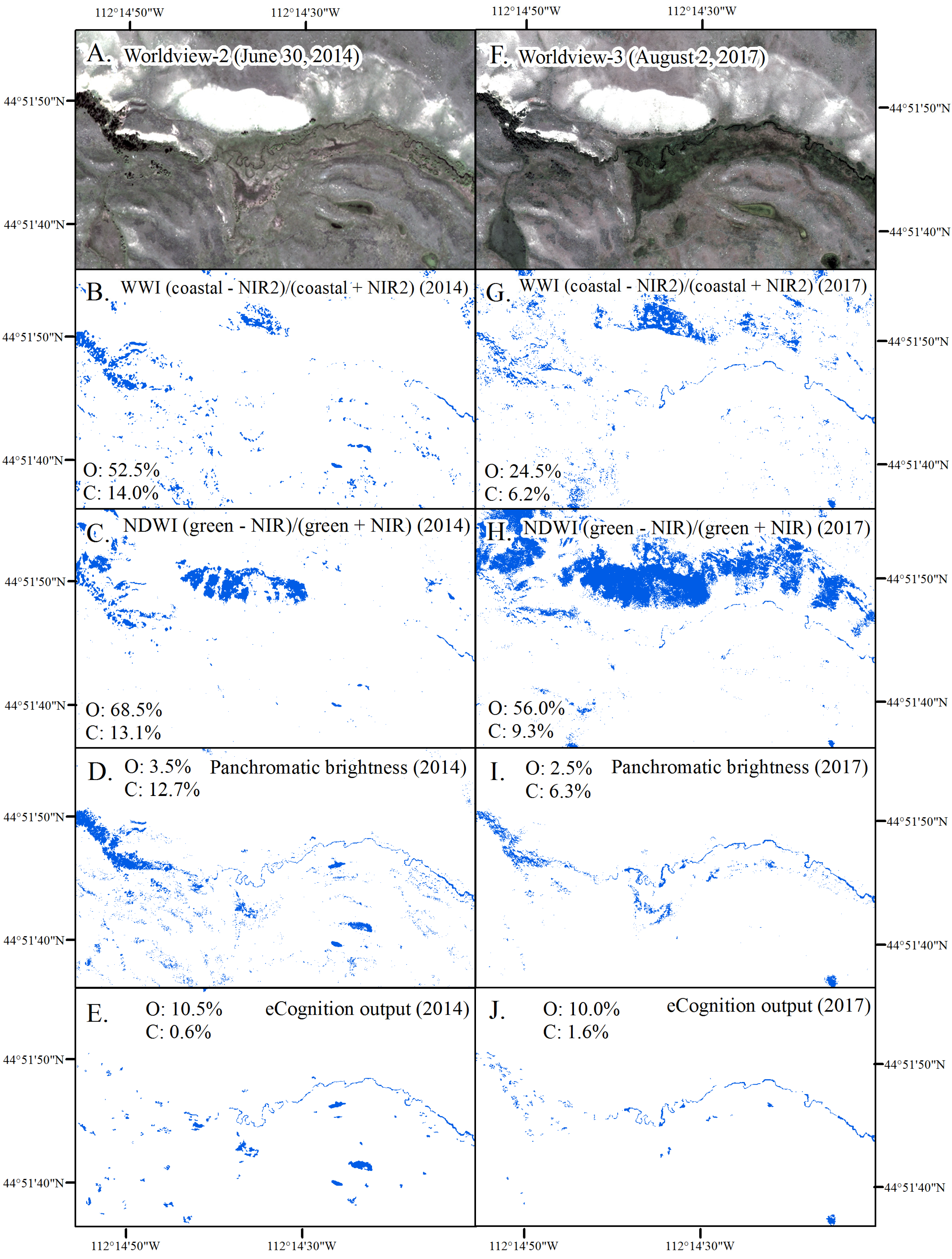
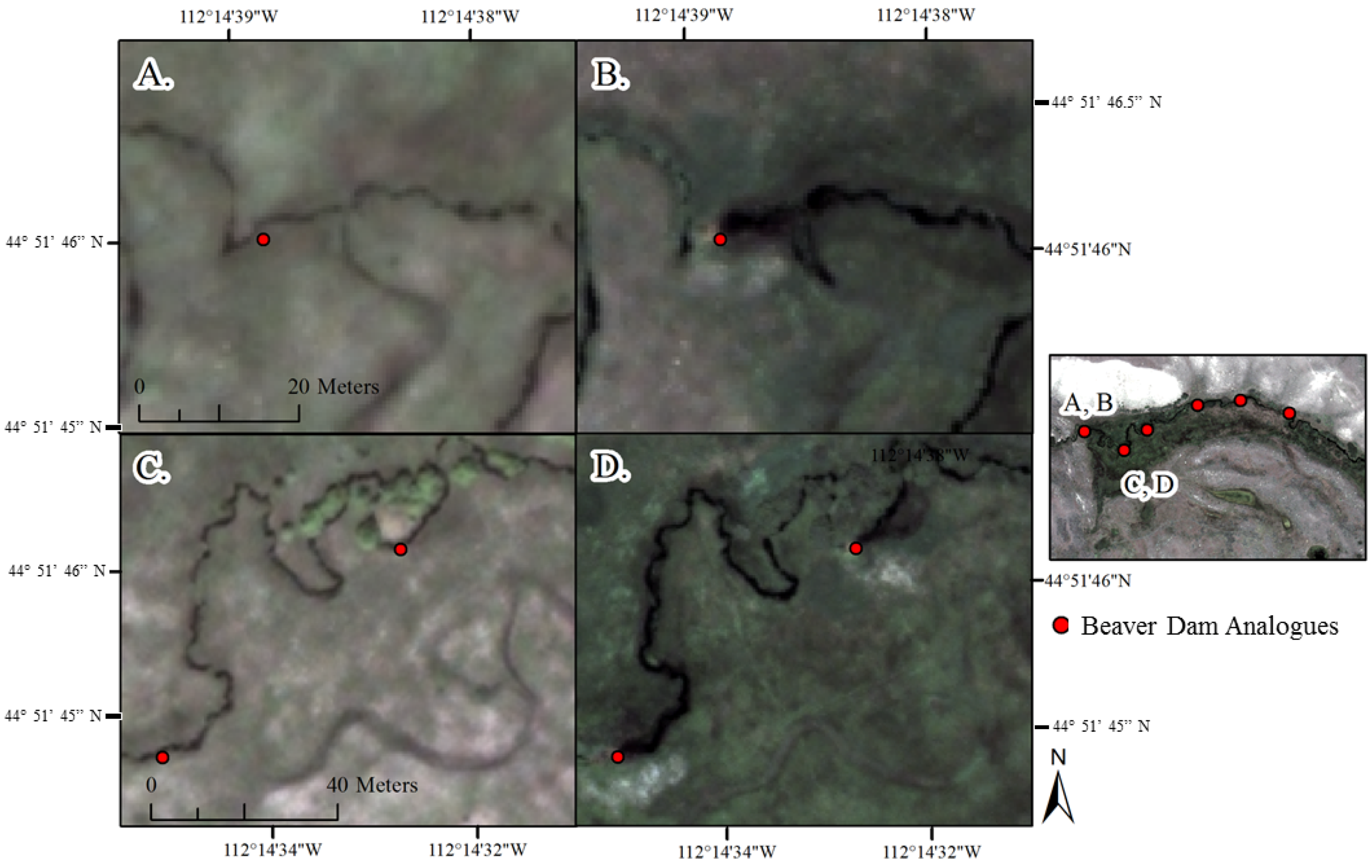
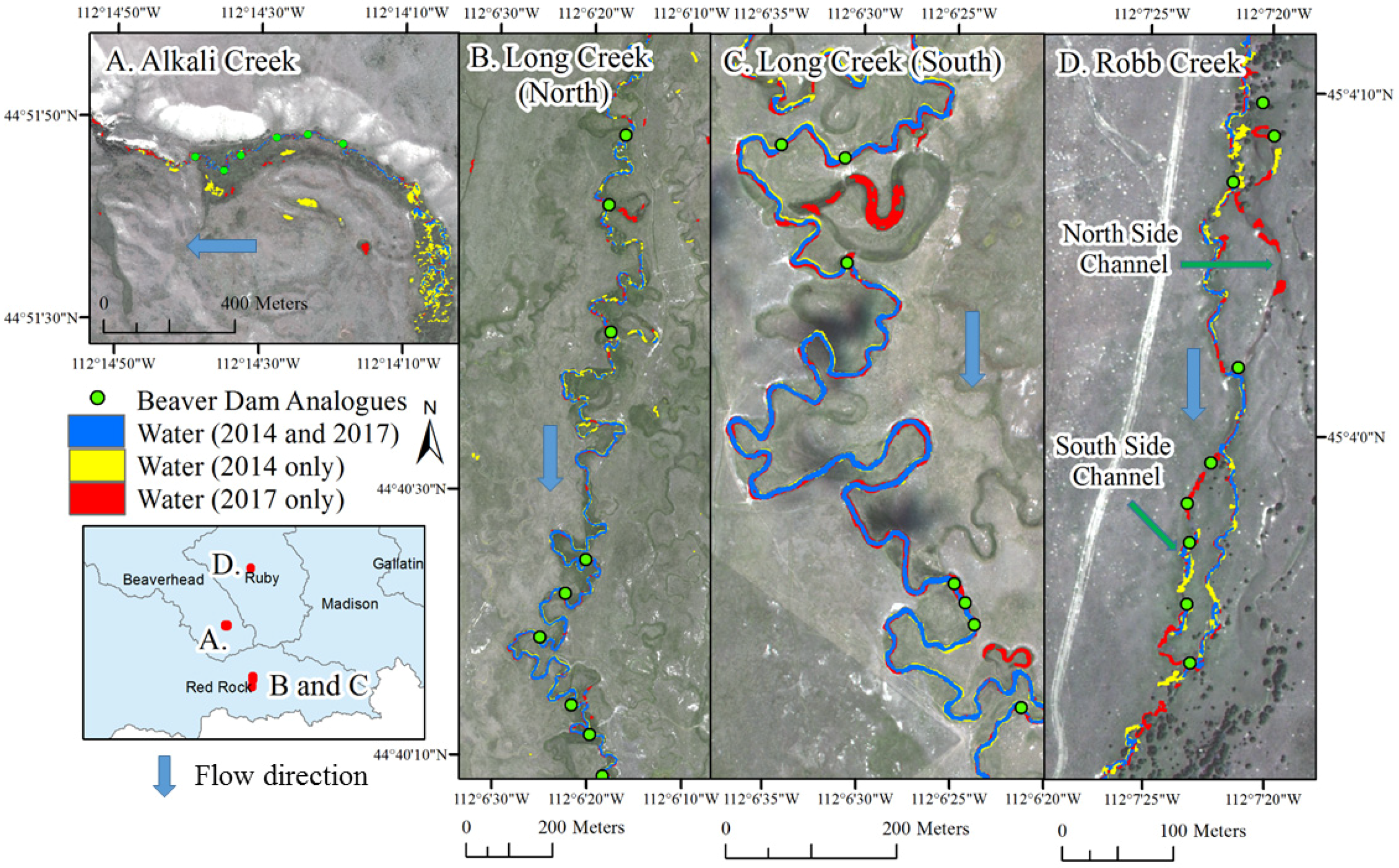
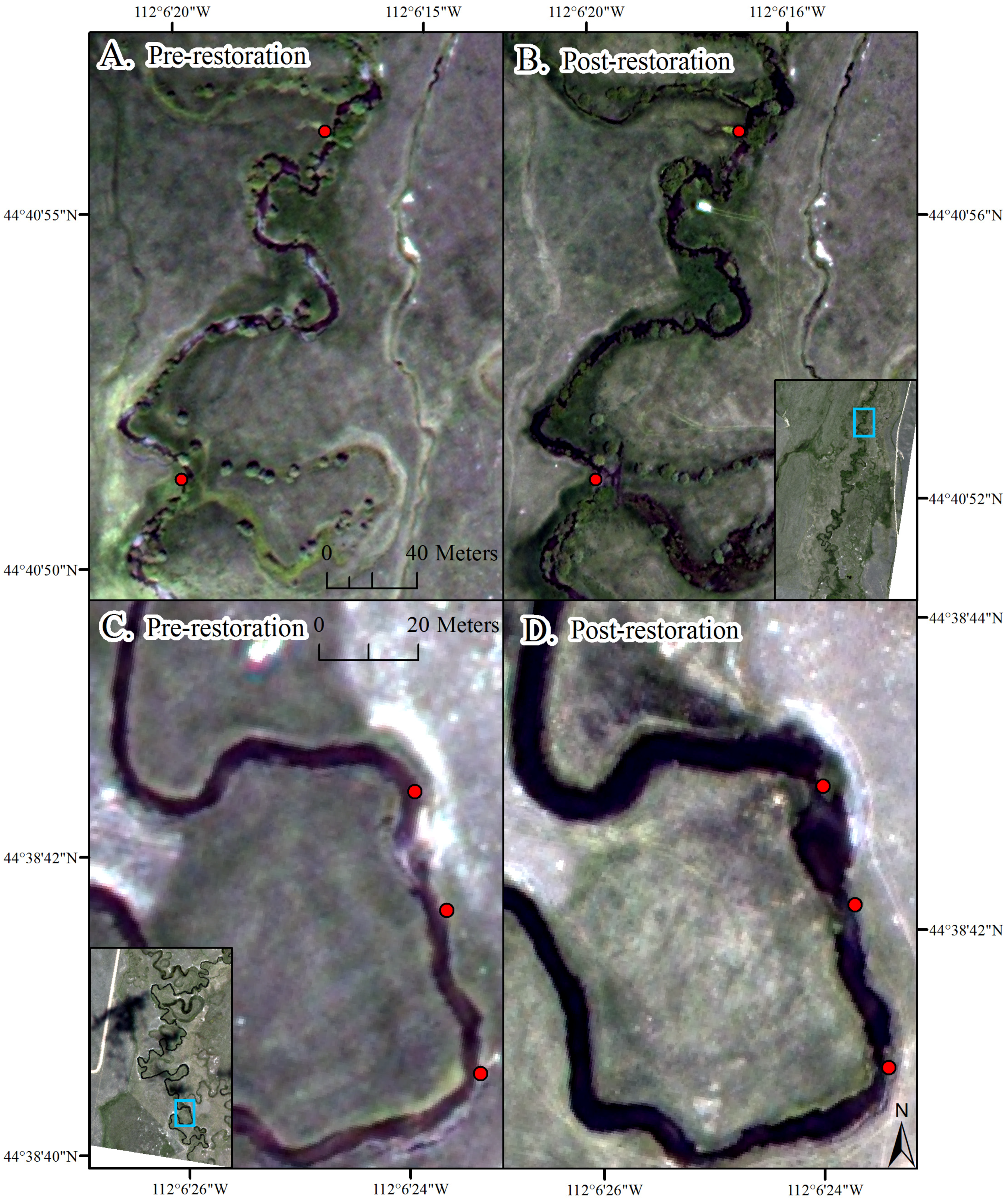
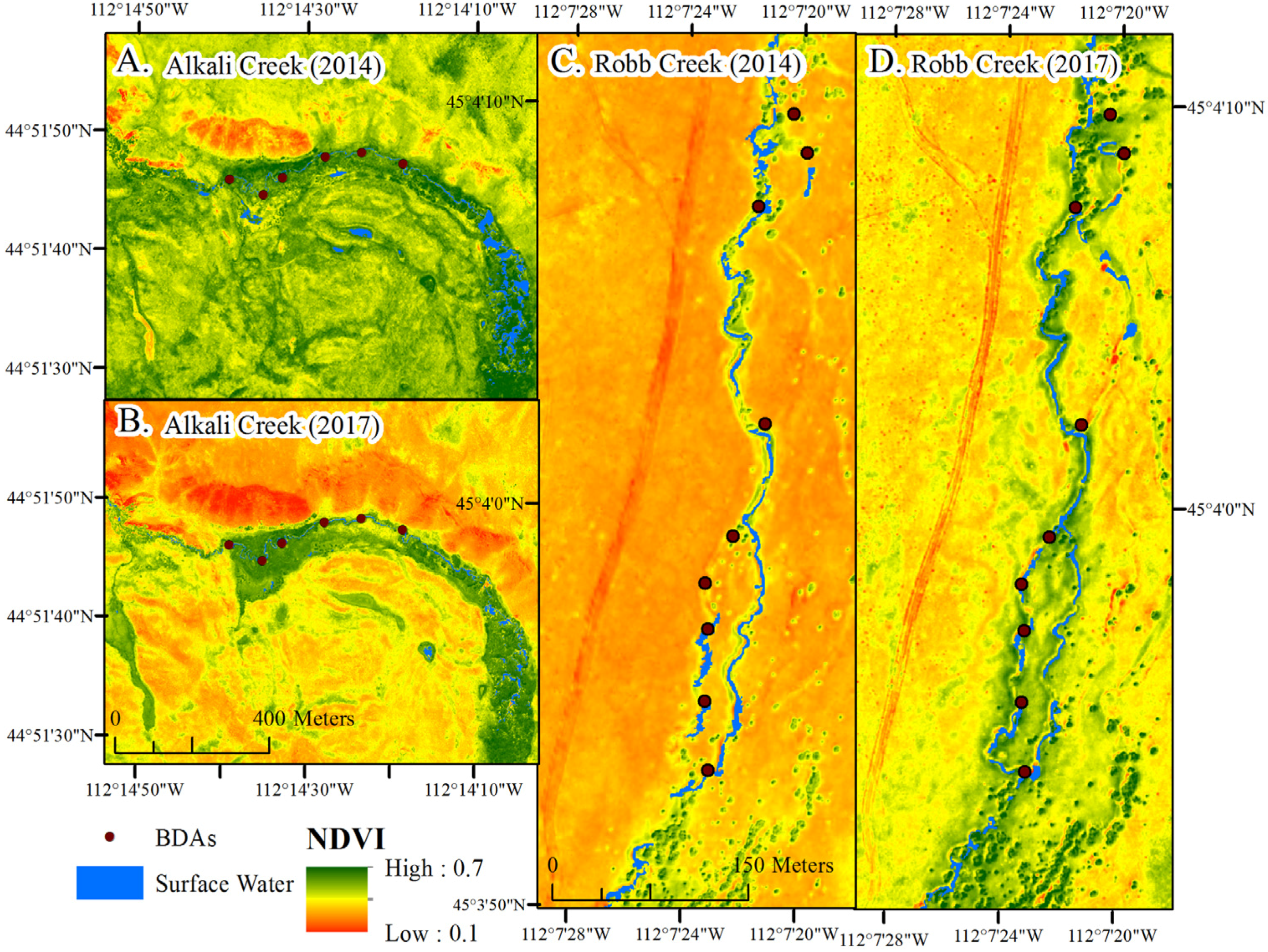

| Site | Elevation (m) | Slope (%) | Sinuosity | Width (Pre-Restoration, m) | BDAs (Length, m) | Willow Stakes | Restoration Date | Years Since Restoration |
|---|---|---|---|---|---|---|---|---|
| Alkali Creek | 2249 | 2.1 | 2.1 | 1.6 | 6 (830) | ~ | 16-Oct | 1 |
| Long Creek (North) | 2033 | 0.9 | 2.7 | 3.5 | 9 (3857) | 800 | 16-Aug | 1 |
| Long Creek (South) | 2014 | 1 | 3.7 | 3.7 | 7 (2496) | 2500 | 14-Sep | 3 |
| Robb Creek | 1793 | 2.6 | 1.1 | 1.8 | 12 (1232) | 2915 | 15-Nov | 2 |
| Site | Pre-Image Date | Jefferson River Discharge (m3 s−1) (Daily Mean) | Pre-Image Source | Mean Off-Nadir View Angle | Post-Image Date | Jefferson River Discharge (m3 s−1) (Daily Mean) | Post-Image Source | Mean Off-Nadir View Angle |
| Alkali Creek | 30-Jun-14 | 126.9 | Worldview-2 | 21.5 | 2-Aug-17 | 15.4 | Worldview-3 | 17 |
| Long Creek (North) | 30-Jun-14 | 126.9 | Worldview-2 | 21.9 | 20-Jun-17 | 140.5 | Worldview-3 | 19 |
| Long Creek (South) | 30-Jun-14 | 126.9 | Worldview-2 | 21.9 | 20-Jun-17 | 140.5 | Worldview-3 | 19 |
| Robb Creek | 23-Jun-14 | 117.8 | QuickBird-2 | 11.7 | 23-Jun-17 | 108.2 | Worldview-2 | 28.3 |
| Index | Equation | Purpose |
|---|---|---|
| Normalized Difference Water Index (NDWI) | (Green − NIR1)/(Green + NIR1) | stream surface water area |
| Worldview Water Index (WWI) | (Coastal − NIR2)/(Coastal + NIR2) | stream surface water area |
| Panchromatic brightness | stream surface water area, bare ground, shadows | |
| Enhanced Vegetation Index (EVI) | 2.5 × (NIR1 − Red)/((NIR1 + 6) × (Red − 7.5) × (Blue + 1) | vegetation |
| Normalized Difference Vegetation Index (NDVI) | (NIR1 − Red)/(NIR1 + Red) | vegetation, riparian |
| NDVI and EVI difference | (NDVI − EVI)/(NDVI + EVI) | vegetation, riparian |
| Soil-Adjusted Vegetation Index (SAVI) | (NIR − red)/(NIR + red + L) × (1 + L), L = 0.5 | vegetation, riparian |
| Green-Red Vegetation Index (GRVI) | (Green − Red)/(Green + Red) | bare ground |
| Worldview Shade Index | (Coastal − Blue)/(Coastal + Blue) | shadows (Worldview) |
| QuickBird Shade Index | (Blue − Green)/(Blue + Green) | shadows (QuickBird) |
| NDWI v2 | (Coastal − NIR1)/(Coastal + NIR1) | deep water |
| Red Edge NDWI | (Red Edge − NIR1)/(Red Edge + NIR1) | shallow water |
| Red Edge WWI | (Red Edge − NIR2)/(Red Edge + NIR2) | shallow water |
| Normalized Difference Coastal Red Edge Index (NDCREI) | (Coastal − Red Edge)/(Coastal + Red Edge) | turbid water |
| Site and Method | Image Year/Sensor | Youden’s Index Threshold | AUC | OE (%) | CE (%) | OA (%) | DC (%) | RB (%) |
|---|---|---|---|---|---|---|---|---|
| Alkali Creek | ||||||||
| WWI (coastal − NIR2)/(coastal + NIR2) | 2014, WV2 | −0.211 | 0.75 | 52.5 | 14.0 | 69.9 | 61.2 | −44.8 |
| NDWI (green − NIR)/(green + NIR) | 2014, WV2 | −0.316 | 0.60 | 68.5 | 13.1 | 63.4 | 46.2 | −63.8 |
| Panchromatic brightness | 2014, WV2 | 0.080 | 0.91 | 3.5 | 12.7 | 91.3 | 91.7 | 10.5 |
| eCognition | 2014, WV2 | ~ | ~ | 10.5 | 0.6 | 94.5 | 94.2 | −10.0 |
| WWI (coastal − NIR2)/(coastal + NIR2) | 2017, WV3 | −0.176 | 0.91 | 24.5 | 6.2 | 85.3 | 83.7 | −19.5 |
| NDWI (green − NIR)/(green + NIR) | 2017, WV3 | −0.277 | 0.68 | 56.0 | 9.3 | 69.8 | 59.3 | −51.5 |
| Panchromatic brightness | 2017, WV3 | 0.123 | 0.97 | 2.5 | 6.3 | 95.5 | 95.6 | 4.0 |
| eCognition | 2017, WV3 | ~ | ~ | 10.0 | 1.6 | 94.3 | 94.0 | −8.5 |
| Long Creek (North) | ||||||||
| WWI (coastal − NIR2)/(coastal + NIR2) | 2014, WV2 | −0.225 | 0.94 | 15.0 | 4.0 | 90.8 | 90.2 | −11.5 |
| NDWI (green − NIR)/(green + NIR) | 2014, WV2 | −0.389 | 0.92 | 36.5 | 0.8 | 81.5 | 77.4 | −36.0 |
| Panchromatic brightness | 2014, WV2 | 0.079 | 0.98 | 6.0 | 1.6 | 96.3 | 96.2 | −4.5 |
| eCognition | 2014, WV2 | ~ | ~ | 4.5 | 2.1 | 96.8 | 96.7 | −2.5 |
| WWI (coastal − NIR2)/(coastal + NIR2) | 2017, WV3 | −0.183 | 0.98 | 5.5 | 3.1 | 95.8 | 95.7 | −2.5 |
| NDWI (green − NIR)/(green + NIR) | 2017, WV3 | −0.326 | 0.97 | 9.0 | 2.2 | 94.5 | 94.3 | −7.0 |
| Panchromatic brightness | 2017, WV3 | 0.102 | 1.00 | 2.5 | 0.5 | 98.5 | 98.5 | −2.0 |
| eCognition | 2017, WV3 | ~ | ~ | 4.0 | 0.5 | 97.8 | 97.7 | −3.5 |
| Long Creek (South) | ||||||||
| WWI (coastal − NIR2)/(coastal + NIR2) | 2014, WV2 | −0.083 | 0.98 | 4.0 | 3.5 | 96.3 | 96.2 | −0.5 |
| NDWI (green − NIR)/(green + NIR) | 2014, WV2 | −0.274 | 0.98 | 6.5 | 4.6 | 94.5 | 94.4 | −2.0 |
| Panchromatic brightness | 2014, WV2 | 0.076 | 0.99 | 2.0 | 1.5 | 98.3 | 98.2 | −0.5 |
| eCognition | 2014, WV2 | ~ | ~ | 1.5 | 6.6 | 95.8 | 95.9 | 5.5 |
| WWI (coastal − NIR2)/(coastal + NIR2) | 2017, WV3 | −0.055 | 0.99 | 2.0 | 3.4 | 97.3 | 97.3 | 1.5 |
| NDWI (green − NIR)/(green + NIR) | 2017, WV3 | −0.234 | 0.96 | 10.5 | 3.8 | 93.0 | 92.7 | −7.0 |
| Panchromatic brightness | 2017, WV3 | 0.081 | 0.99 | 2.0 | 1.0 | 98.5 | 98.5 | −1.0 |
| eCognition | 2017, WV3 | ~ | ~ | 2.0 | 1.0 | 98.5 | 98.5 | −1.0 |
| Robb Creek | ||||||||
| WWI (coastal − NIR2)/(coastal + NIR2) | 2014, QB2 | ~ | ~ | ~ | ~ | ~ | ~ | ~ |
| NDWI (green − NIR)/(green + NIR) | 2014, QB2 | −0.278 | 0.74 | 62.5 | 2.6 | 68.3 | 54.2 | −61.5 |
| Panchromatic brightness | 2014, QB2 | 0.137 | 0.94 | 4.0 | 7.2 | 94.3 | 94.3 | 3.5 |
| eCognition | 2014, QB2 | ~ | ~ | 6.5 | 2.1 | 95.8 | 95.7 | −4.5 |
| WWI (coastal − NIR2)/(coastal + NIR2) | 2017, WV2 | −0.243 | 0.96 | 16.0 | 4.5 | 90.0 | 89.4 | −12.0 |
| NDWI (green − NIR)/(green + NIR) | 2017, WV2 | −0.299 | 0.70 | 36.5 | 8.6 | 78.8 | 74.9 | −30.5 |
| Panchromatic brightness | 2017, WV2 | 0.103 | 0.97 | 0.5 | 4.8 | 97.3 | 97.3 | 4.5 |
| eCognition | 2017, WV2 | ~ | ~ | 2.5 | 3.0 | 97.3 | 97.3 | 0.5 |
| Stream and Reach | Length (m) | Area (2014, m2) | Area (2017, m2) | Change (%) | Change Relative to Expected (%) | Inundated Stream Length (2014, %) | Inundated Stream Length (2017, %) | Surface Water Width (2014, m) | Surface Water Width (2017, m) | Local Storage Increase (Mean Per BDA) (m2) |
|---|---|---|---|---|---|---|---|---|---|---|
| Alkali Creek | ||||||||||
| Upstream Beaver Activity | 592 | 9665.3 | 2564.3 | −73.5 | 97 | 96 | 2.4 | 1.9 | ||
| Upstream Reach | 200 | 648.5 | 630.0 | −2.9 | 94 | 99 | 2.3 | 3.2 | ||
| Restoration reach | 830 | 1311.5 | 1595.5 | 21.7 | 25.2 | 87 | 86 | 1.6 | 1.8 | 302.9 (50.5) |
| Downstream (0 to 300 m) | 300 | 594.5 | 403.8 | −32.1 | −30.1 | 37 | 63 | 1.4 | 1.1 | |
| Long Creek (North) | ||||||||||
| Upstream Reach | 300 | 643.3 | 589.7 | −8.3 | 75 | 79 | 2.4 | 2.8 | ||
| Restoration reach | 3857 | 12,713.0 | 11,080.0 | −12.8 | −4.9 | 91 | 90 | 3.5 | 3.6 | 170.5 (18.9) |
| Downstream (0 to 250 m) | 250 | 673.0 | 561.4 | −16.6 | −9.0 | 91 | 97 | 2.8 | 2.3 | |
| Downstream (250 to 500 m) | 250 | 1059.0 | 819.8 | −22.6 | −15.6 | 98 | 98 | 3.6 | 3.5 | |
| Downstream (500 m to 1 km) | 500 | 1492.5 | 1183.9 | −20.7 | −13.5 | 92 | 93 | 3.0 | 2.7 | |
| Long Creek (South) | ||||||||||
| Upstream Reach | 300 | 981.0 | 1028.4 | 4.8 | 100 | 100 | 2.9 | 3.6 | ||
| Restoration reach | 2496 | 10,424.5 | 12,434.3 | 19.3 | 13.8 | 98 | 100 | 3.7 | 5.1 | 746.7 (106.7) |
| Downstream (0 to 250 m) | 250 | 780.3 | 653.8 | −16.2 | −20.1 | 100 | 100 | 2.7 | 3.0 | |
| Downstream (250 to 500 m) | 250 | 1030.4 | 900.6 | −12.6 | −16.6 | 100 | 100 | 3.5 | 3.5 | |
| Downstream (500 m to 1 km) | 500 | 2213.4 | 2209.8 | −0.2 | −4.8 | 100 | 100 | 3.0 | 3.3 | |
| Robb Creek | ||||||||||
| Upstream Reach | 300 | 490.4 | 501.3 | 2.2 | 99 | 95 | 1.8 | 1.8 | ||
| Main Stem | 691 | 2100.4 | 1566.2 | −25.4 | −27.1 | 92 | 86 | 1.8 | 2.3 | |
| Restored Side Channel (South) | 284 | 77.8 | 362.8 | 366.6 | 356.4 | 8 | 39 | 0.0 | 1.2 | |
| Restored Side Channel (North) | 257 | 292.5 | 531.1 | 81.6 | 77.6 | 40 | 73 | 1.5 | 2.5 | |
| Downstream (0 to 250 m) | 250 | 863.3 | 651.0 | −24.6 | −26.2 | 78 | 84 | 1.8 | 2.0 | |
| Downstream (250 to 500 m) | 250 | 704.6 | 495.2 | −29.7 | −31.2 | 21 | 49 | 1.6 | 1.8 | |
| Downstream (500 m to 1 km) | 500 | 1092.8 | 1117.4 | 2.3 | 0.0 | 79 | 70 | 1.7 | 1.7 |
| Index (Buffer) | SAVI (%) (10 m) | SAVI (%) (15 m) | SAVI (%) (20 m) | EVI (%) (10 m) | EVI (%) (15 m) | EVI (%) (20 m) | NDVI (%) (10 m) | NDVI (%) (15 m) | NDVI (%) (20 m) | Average (%) (10 m) | Average (%) (15 m) | Average (%) (20 m) |
|---|---|---|---|---|---|---|---|---|---|---|---|---|
| Alkali Creek | ||||||||||||
| Restoration reach | 18.2 | 15.5 | 13.3 | 24.6 | 21.1 | 18.3 | 17.4 | 15.4 | 13.6 | 20.1 | 17.3 | 15.1 |
| 0 to 250 m DS | 12.2 | 9.5 | 7.0 | 16.6 | 13.3 | 10.3 | 7.9 | 5.6 | 3.1 | 12.2 | 9.5 | 6.8 |
| 250 to 500 m DS | 29.6 | 30.5 | 29.1 | 37.8 | 38.6 | 37.1 | 7.3 | 7.5 | 7.1 | 24.9 | 25.5 | 24.4 |
| 500 to 1 km DS | 25.2 | 27.3 | 26.3 | 33.2 | 35.2 | 34.1 | 6.6 | 7.5 | 6.6 | 21.7 | 23.3 | 22.3 |
| Long Creek (North) | ||||||||||||
| Restoration reach | 8.6 | 8.0 | 7.8 | 6.0 | 5.4 | 5.2 | 10.5 | 9.3 | 8.7 | 8.4 | 7.6 | 7.2 |
| 0 to 250 m DS | 14.3 | 14.7 | 13.4 | 11.9 | 12.2 | 10.8 | 17.2 | 16.3 | 15.1 | 14.5 | 14.4 | 13.1 |
| 250 to 500 m DS | 1.2 | −1.2 | 1.2 | −1.9 | −4.2 | −1.7 | 8.2 | 5.2 | 6.4 | 2.5 | −0.1 | 2.0 |
| 500 to 1 km DS | −18.6 | −16.9 | −16.5 | −22.7 | −20.8 | −20.4 | −6.0 | −5.5 | −5.3 | −15.8 | −14.4 | −14.1 |
| Long Creek (South) | ||||||||||||
| Restoration reach | −0.4 | −1.0 | −0.2 | −4.4 | −4.7 | −4.0 | −2.3 | −3.5 | −3.1 | −2.4 | −3.1 | −2.4 |
| 0 to 250 m DS | −0.6 | 0.6 | −0.3 | −4.7 | 0.3 | −4.1 | −5.5 | −4.4 | −5.4 | −3.6 | −1.2 | −3.3 |
| 250 to 500 m DS | −1.5 | −1.9 | −1.9 | −5.6 | −5.6 | −5.7 | −7.0 | −7.6 | −8.3 | −4.7 | −5.0 | −5.3 |
| 500 to 1 km DS | 0.7 | −0.5 | −0.3 | −3.3 | −4.3 | −4.3 | −5.5 | −7.0 | −7.6 | −2.7 | −3.9 | −4.1 |
| Robb Creek | ||||||||||||
| Main Stem | 3.5 | 4.5 | 4.3 | 4.8 | 5.8 | 5.6 | 2.3 | 3.2 | 3.3 | 3.5 | 4.5 | 4.4 |
| Side Stem (N) | −0.4 | 1.4 | 2.1 | 1.0 | 2.7 | 3.6 | 3.2 | 4.1 | 4.2 | 1.3 | 2.7 | 3.3 |
| Side Stem (S) | 21.6 | 22.8 | 22.1 | 23.4 | 24.9 | 24.1 | 16.4 | 17.5 | 16.9 | 20.5 | 21.7 | 21.0 |
| 0 to 250 m DS | −5.6 | −3.8 | −2.5 | −4.6 | −2.8 | −1.5 | −6.5 | −5.0 | −3.9 | −5.6 | −3.9 | −2.6 |
| 250 to 500 m DS | −13.8 | −13.4 | −13.3 | −12.1 | −12.0 | −11.9 | −10.3 | −10.7 | −10.8 | −12.1 | −12.0 | −12.0 |
| 500 to 1 km DS | −11.2 | −11.0 | −10.4 | −10.2 | −10.0 | −9.5 | −10.8 | −11.0 | −10.6 | −10.7 | −10.7 | −10.2 |
© 2018 by the authors. Licensee MDPI, Basel, Switzerland. This article is an open access article distributed under the terms and conditions of the Creative Commons Attribution (CC BY) license (http://creativecommons.org/licenses/by/4.0/).
Share and Cite
Vanderhoof, M.K.; Burt, C. Applying High-Resolution Imagery to Evaluate Restoration-Induced Changes in Stream Condition, Missouri River Headwaters Basin, Montana. Remote Sens. 2018, 10, 913. https://doi.org/10.3390/rs10060913
Vanderhoof MK, Burt C. Applying High-Resolution Imagery to Evaluate Restoration-Induced Changes in Stream Condition, Missouri River Headwaters Basin, Montana. Remote Sensing. 2018; 10(6):913. https://doi.org/10.3390/rs10060913
Chicago/Turabian StyleVanderhoof, Melanie K., and Clifton Burt. 2018. "Applying High-Resolution Imagery to Evaluate Restoration-Induced Changes in Stream Condition, Missouri River Headwaters Basin, Montana" Remote Sensing 10, no. 6: 913. https://doi.org/10.3390/rs10060913
APA StyleVanderhoof, M. K., & Burt, C. (2018). Applying High-Resolution Imagery to Evaluate Restoration-Induced Changes in Stream Condition, Missouri River Headwaters Basin, Montana. Remote Sensing, 10(6), 913. https://doi.org/10.3390/rs10060913





